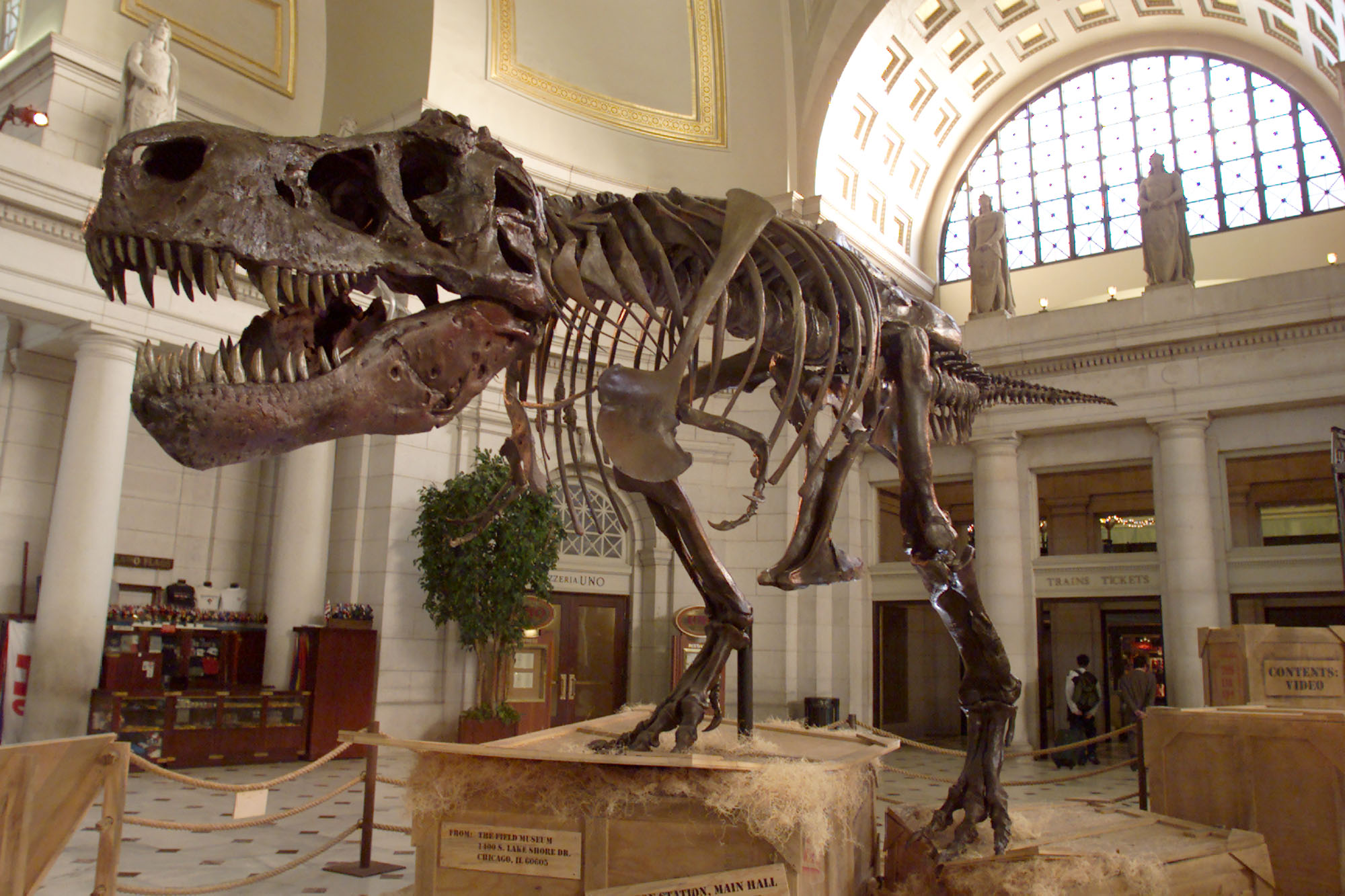How to buy your own T. rex
Movie stars, hedge-fund moguls, and oil-rich sheikhs are paying top dollar for dinosaur fossils in private auctions

The world's most famous paleontologist doesn't understand why anyone wants to collect dinosaurs. Mark Norell sits across from me in his expansive corner office at the American Museum of Natural History in New York City and launches right in: "People are weird. I think, 'Who is buying this?'"
I first heard about private dinosaur collecting in 2007, when the actors Leonardo DiCaprio and Nicolas Cage engaged in a bidding war over a 32-inch Tyrannosaurus bataar skull at an auction in Beverly Hills. In the end, Cage outbid his rival with a $276,000 offer. (Just before Christmas 2015, Cage returned it on an order from the Department of Homeland Security; unbeknownst to him, he had bought a dinosaur part smuggled out of Mongolia.)
Since that auction, I perk up whenever I see news about any other big-name dinosaur collectors: the film directors James Cameron and Ron Howard; actor Brad Pitt; and Nathan Myhrvold, Microsoft's former chief technology officer, who according to Men's Journal has a Tyrannosaurus rex skeleton in a glass solarium in his large home in Bellevue, Washington. Various high-flying sheikhs are in on the pastime, too. Former U.S. House Speaker Newt Gingrich kept a T. rex skull cast in his office.
The Week
Escape your echo chamber. Get the facts behind the news, plus analysis from multiple perspectives.

Sign up for The Week's Free Newsletters
From our morning news briefing to a weekly Good News Newsletter, get the best of The Week delivered directly to your inbox.
From our morning news briefing to a weekly Good News Newsletter, get the best of The Week delivered directly to your inbox.
As I read more about this current crop of rich male (always male, it seems) collectors, I gave them their own species name: Abundus egocentrus. I tried to understand their motivation. Was having a big vicious dinosaur on display akin to owning a huge scary dog like a Rottweiler? Were they saying to the world, "Look what I can tame!" Or maybe there were deeper psychological implications. Did collecting dinosaur fossils tap into childhood issues, delivering a soothing narrative about where we came from?
My first step for getting answers was to talk to the person Time magazine nicknamed "Dino Man." Who better to explain the mindset of those amassing dinosaur bones than the man who oversees the dinosaurs that attract 5 million visitors a year?
Norell, 58, surprisingly chatty and undeniably hip, is chairman of the museum's Division of Paleontology. He's best known for excavating dinosaurs sitting on nests, baby dino embryos fossilized beneath their haunches, not to mention his storied work on feathered theropods. Just back from a fossil tour of China, Norell was getting ready to go out in the field again, somewhere in the Gobi Desert.
In preparation, I had swiftly transformed myself into a walking version of The Complete Idiot's Guide to Dinosaurs and the relatively brief history of humans collecting their bones. In the 1870s, a fossil-collecting frenzy that had sprung up in Great Britain spread across the pond and found its way westward into northern Wyoming. There, an extreme rivalry brewed between two titans of early U.S. paleontology: Edward Drinker Cope and Othniel Charles Marsh. Historians refer to their long, ugly feud, which saw them jostling for scientific supremacy and using underhanded methods to discredit each other, as the Bone Wars. Despite their enmity, between them they'd named 136 dinosaur species by 1892.
A free daily email with the biggest news stories of the day – and the best features from TheWeek.com
The collecting mania in the U.S. intensified again at the tail end of the 19th century. On Dec. 11, 1898, The New York Journal and Advertiser ran a headline that caught the fancy of many, including the philanthropist Andrew Carnegie: "Most Colossal Animal Ever on Earth Just Found Out West." The titillating copy featured a Brontosaurus giganteus peering into the New York Life building to illustrate the size of the find. It was not a factual story — only a single leg bone was found, in Laramie, Wyoming — but the filthy-rich Carnegie was now longing for a dinosaur of his own. He financed great discoveries, including 'Dippy' (Diplodocus carnegii), composed of bones unearthed along Sheep Creek in Wyoming, and a startlingly large dinosaur that he named for his wife (Apatosaurus louisae), pieced together from finds in his private quarry in Vernal, Utah.
In Norell's view, dinosaur collectors today are not merely harmless science wannabes. They cause serious saurus tsuris for those in the museum world. "Prices have ballooned for finds on private land. Museums don't have the funds to compete with the actors and hedge-fund guys. If there is a great amateur discovery, don't you think it should advance science?" He also pooh-poohs reports that you can make a fortune in dinosaurs, because, as he puts it, you can always get more for a Seurat than for a Stegosaurus. "And keep in mind they are incredibly not liquid. You can't say, 'Oh, I need some money, I'm going to sell my Bambiraptor.'"
The highest-priced dinosaur ever offered by a private seller was Sue, the largest T. rex specimen ever found, which back in 1997 reportedly even attracted a bid from Michael Jackson. After the pandemonium died down, the Field Museum of Chicago was the victor. "What's $8 million and change to someone who invests in art? And that sale was a one-off, it really didn't happen again," Norell sniffs. More recently, Bonhams in New York touted the auction of a theropod and a large horned ceratopsian locked in mortal combat. "Well, let me tell you what the auction houses won't tell you," he continues. "For all that publicity, it was a no-go. The guys who excavated thought they'd go to the Bahamas forever. Instead, they didn't make reserve."
Norell doesn't own any dinosaurs. As part of any museum contract, no curator can collect in his or her study area, or authenticate or appraise fossils for private sale. As for the specimens that surround Norell now at the museum, "I guess there are a few around here that are cool, but I sure as hell wouldn't want them in my house."
I press him: What motivates the collectors? "Honestly? Some people are rabid collectors and some people aren't." He raises a finger. "But there's another segment I've come across, especially in the fossil world, which is kind of like hoarders. All they want is more stuff. I have been in people's houses where every possible inch of their home is covered in fossils; even the dishwasher has trilobites in it."
If you want to really get into the head of the collectors, Norell advises, meet with some private dealers to get their perspective. "I'll forewarn you, though, some are shadier than others, and there is a hidden world of secretive dealers, average Joes without a store who trade at fossil shows, almost a Silk Road of dinosaur dealing."
A lot of the visible trading happens in Tucson, at an annual mineral and fossil show held in February. "People come from all over the world. They always have someone there from Homeland Security, and ICE (the U.S. Immigration and Customs Enforcement)," Norell says.
As Nicolas Cage found out, even big-time buyers can fall foul of anti-smuggling laws. Some of the sellers can knowingly skirt the law. "Crazy stuff goes to Dubai, to Qatar, and pretty regularly to Singapore. And there are all sorts of big odd collections in Germany," Norell tells me. Despite his gripes, he says he genuinely likes some of the private fossil dealers.
Plenty of dino dealing takes place right near my Manhattan home. A year prior to my conversation with Norell, I'd seen a velociraptor claw for sale in a fine-gems store on Fifth Avenue, across the street from Lord & Taylor. Astro Gallery of Gems is the largest gem and mineral store in the world, whose devoted clients have included Salvador Dalí and John Lennon. As I suspected, it is also a dinosaur dealership on the side. "Dinosaurs are not as easy sales as you think," Dennis Tanjeloff, the 48-year-old president and CEO, confides to me. His subterranean office is heavily guarded with expensive digital security; this netherworld below the upstairs public gallery is filled with glinting gemstones and a strange assortment of ancient bones.
Tanjeloff notices me eyeing a pterodactyl-like skeleton a few feet away. "You like my little guy? He's an Odontopteryx toliapica, a prehistoric waterfowl. $125,000."
Tanjeloff describes his ideal dinosaur customer as a grown-up boy who never got over the revelation that prehistoric creatures were real, or that they were on this planet so many million years ago. I agree that we all know that kid who picks his favorite dinosaurs, learns their names and families. "Yes, that's the one. As he got slightly older, he began to process what 200 million years means, and was still enraptured by the thought of a creature that ate three tons of vegetation a day and needed 3,000 teeth to chew dinner."
These days, Tanjeloff mostly buys and sells fossils dug out of private property — and makes no apologies. He also sources fossils directly from paleontologists and geologists, other fossil dealers, and old collections. "Sometimes people have to be reminded that dinosaurs are not in danger of going extinct, you know? They already are. So you are not hurting any creature by selling, trading, or looking for dinosaur fossils; in that way, it is also just like gem collecting." On the flip side, he doesn't peddle to U.S. museums, because "they are federally funded and frankly do not have much money."
Once again, the obsession of the collector and the obsession of the scientist are at odds. I mention that Norell doesn't think much of fossils as investments. Tanjeloff gleams his teeth at me, shaking his head in disagreement: "Scientists don't want to put a value on the dinosaurs; they consider them national treasures for scientific reasons. They don't like a wealthy person taking what they think belongs to everyone to see and enjoy."
Still, Tanjeloff tells me, most of his clients take pride in their collecting choices, and many end up donating their fossils to research. About "80 percent of the time," a buyer won't hold on to his precious bones until the bitter end, despite his initial swagger, so they ultimately end up in a museum or university anyway.
Dinosaur collectors are proving not as easy to classify as I'd hoped. Some people want to possess the best, it seems. Some want to be seen as generous benefactors. And despite what Norell told me, I'm realizing that old-fashioned market speculation is another distinct motivation. "My dinosaurs don't have quarterly reviews, but look at the past 30 years — what you could have bought back then, and what it would cost you now! Even with inflation, the compound is astronomical," Tanjeloff says. "And the numbers today are staggering. There are people spending way more than James Cameron. Some of my best dinosaur clients have very, very large homes."
As I wrap up my visit, my host ponders a jawbone sitting in his inbox and offers another theory. "I strongly believe that this is just the beginning of a craze. I think because the world is so tech-y, and we all live behind screens, that people are really going back to nature. I sell thousands of little fossils a week. We had a section called Astro Kids in the old FAO Schwartz toy store, and when they relaunch next year, we'll be back. Boys who love dinosaurs, they're our future customers."
Excerpted from an article that was originally published by Aeon Media, a digital magazine for ideas and culture. Follow them on Twitter at @aeonmag.
-
 Step into a fairy tale at San Ysidro Ranch
Step into a fairy tale at San Ysidro RanchThe Week Recommends This historic Californian hideaway is pure magic
-
 Best panettones for Christmas 2025: tried and tasted
Best panettones for Christmas 2025: tried and tastedThe Week Recommends Festive, fluffy and full of joy, these panettones provide magic in every bite
-
 Crossword: December 1, 2025
Crossword: December 1, 2025The daily crossword from The Week